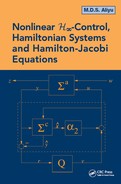10.3 Aggregate Filters
If the coordinate transformation, φ, discussed in the previous section cannot be found, then an aggregate filter for the system (10.1) must be designed. Accordingly, consider the following class of filters:
Fa3ag:{‵x1=f1(‵x1,‵x2)+g11(‵x1,‵x2)‵w⋆+‵L1(‵x,y)(y−h21(‵x1)+h22(‵x2)); ‵x1(t0)=0ε‵x2=f1(‵x1,‵x2)+g12(‵x1,‵x2)‵w⋆+‵L2(‵x,y)(y−h21(‵x1)+h22(‵x2)); ‵x2(t0)=0 ‵z=y−h21(‵x1)+h22(‵x2)Fa3ag:⎧⎩⎨⎪⎪⎪⎪⎪⎪⎪⎪⎪⎪⎪⎪⎪⎪⎪⎪⎪⎪⎪⎪⎪⎪x‵1=f1(x‵1,x‵2)+g11(x‵1,x‵2)w⋆‵+L‵1(x‵,y)(y−h21(x‵1)+h22(x‵2)); x‵1(t0)=0εx‵2=f1(x‵1,x‵2)+g12(x‵1,x‵2)w⋆‵+L‵2(x‵,y)(y−h21(x‵1)+h22(x‵2)); x‵2(t0)=0 z‵=y−h21(x‵1)+h22(x‵2)
where ‵L1∈ℜn1×m,‵L2∈ℜn2×mL‵1∈Rn1×m,L‵2∈Rn2×m are the filter gains, and ‵zz‵ is the new penalty variable. Then the following result can be derived using similar steps as outlined in the previous section.
Theorem 10.3.1 Consider the nonlinear system (10.1) and the NLHIFP for it. Suppose the plant Pasp is locally asymptotically-stable about the equilibrium-point x = 0 and observable for all ε∈[0,ε⋆)ε∈[0,ε⋆). Further, suppose for some γ > 0 and ε∈[0,ε⋆)ε∈[0,ε⋆), there exists a C1 positive-semidefinite function ‵V:‵N×‵ϒ→ℜ+V‵:N×‵Υ‵→R+, locally defined in a neighborhood ‵V:‵N×‵ϒ⊂X×YV‵:N×‵Υ‵⊂X×Y of the origin (‵x1,‵x2,y)=(0,0,0),(x‵1,x‵2,y)=(0,0,0),, and matrix functions ‵Li:‵N×‵ϒ→ℜni×mL‵i:N×‵Υ‵→Rni×m, i = 1, 2, satisfying the HJIE:
‵V‵x1(‵x,y)f1(‵x1,‵x2)+1ε‵V‵x2(‵x,y)f1(‵x1,‵x2)+‵Vy(‵x,y)˙y+ 12γ2 [‵V‵x1(‵x,y)‵V‵x2(‵x,y)[g11(‵x)gT11(‵x) 1ε g11(‵x)gT21(‵x) 1ε g21(‵x)gT11(‵x) 1ε2 g21(‵x)gT21(‵x)] [‵VT‵x1(‵x,y)‵VT‵x2(‵x,y)]− 32(y−h21(‵x1)+h22(‵x2))T(y−h21(‵x1)+h22(‵x2))=0,‵V(0,0)=0,V‵x‵1(x‵,y)f1(x‵1,x‵2)+1εV‵x‵2(x‵,y)f1(x‵1,x‵2)+V‵y(x‵,y)y˙+ 12γ2 [V‵x‵1(x‵,y)V‵x‵2(x‵,y)⎡⎣g11(x‵)gT11(x‵) 1ε g11(x‵)gT21(x‵) 1ε g21(x‵)gT11(x‵) 1ε2 g21(x‵)gT21(x‵)⎤⎦ ⎡⎣⎢⎢⎢VTx‵1‵(x‵,y)VTx‵2‵(x‵,y)⎤⎦⎥⎥⎥− 32(y−h21(x‵1)+h22(x‵2))T(y−h21(x‵1)+h22(x‵2))=0,V‵(0,0)=0, |
(10.40) |
together with the side-conditions
‵V‵x1(‵x,y)‵L1(‵x,y)=−(y−h21(‵x1)+h22(‵x2))TV‵x‵1(x‵,y)L‵1(x‵,y)=−(y−h21(x‵1)+h22(x‵2))T |
(10.41) |
1ε‵V‵x2(‵x,y)‵L2(‵x,y)=−(y−h21(‵x1)+h22(‵x2))T1εV‵x‵2(x‵,y)L‵2(x‵,y)=−(y−h21(x‵1)+h22(x‵2))T |
(10.42) |
Then, the filter Fa3ag with
‵w⋆=1γ2[gT11(‵x) ‵V‵x1(‵x,y)+1εg21(‵x)‵V‵x2(‵x,y)]w⋆‵=1γ2[gT11(x‵) V‵x‵1(x‵,y)+1εg21(x‵)V‵x‵2(x‵,y)]
solves the NLHIFP for the system locally in ‵NN‵.
Proof: Proof follows along the same lines as Proposition 10.2.1. □
The above result, Theorem 10.3.1, can similarly be specialized to the LSPS Plsp.
To obtain the limiting filter (10.40) as ε ↓ 0, we use Assumption 10.2.1 to obtain a reduced-order model of the system (10.1). If we assume the equation
0=f2(x1,x2)+˜g21(x1,x2)w0=f2(x1,x2)+g˜21(x1,x2)w |
(10.43) |
has k ≥ 1 isolated roots, we can denote any one of these roots by
ˉx2=p(x1,w),x¯2=p(x1,w), |
(10.44) |
for some smooth function p : X × W → X. The resulting reduced-order system is given by
paspr:{.x1=f1(x1,ˉx2)+g11(x1,ˉx2)w;x1(t0)=x10y=h21(x1)+h22(ˉx2)+k21(x1,ˉx2)w,paspr:⎧⎩⎨⎪⎪x.1=f1(x1,x¯2)+g11(x1,x¯2)w;x1(t0)=x10y=h21(x1)+h22(x¯2)+k21(x1,x¯2)w, |
(10.45) |
and the corresponding reduced-order filter is then given by
Fa3agr:{˙x1=f1(‵x1,p(‵x1,‵w⋆))+g11(‵x1,p(‵x1,‵w⋆))+ ‵L1(‵x,y)(y−h21(‵x1)+h22p(‵x2,‵w⋆)); ‵x1(t0)=0‵z=y−h21(‵x1)+h22p(‵x1,‵w⋆)),Fa3agr:⎧⎩⎨⎪⎪⎪⎪⎪⎪⎪⎪⎪⎪x˙1=f1(x‵1,p(x‵1,w⋆‵))+g11(x‵1,p(x‵1,w⋆‵))+ L‵1(x‵,y)(y−h21(x‵1)+h22p(x‵2,w⋆‵)); x‵1(t0)=0z‵=y−h21(x‵1)+h22p(x‵1,w⋆‵)),
where all the variables have their corresponding previous meanings and dimensions, while
‵w⋆=1γ2gT11(‵x) ‵V‵x1(‵x,y)‵V‵x1(‵x,y)‵L1(‵x,y)=−(y−h21(‵x1)+h22(p(‵x1,‵w⋆))Tw⋆‵=1γ2gT11(x‵) V‵x‵1(x‵,y)V‵x‵1(x‵,y)L‵1(x‵,y)=−(y−h21(x‵1)+h22(p(x‵1,w⋆‵))T
and ‵VV‵ satisfies the following HJIE:
‵V‵x1(‵x,y)f1(‵x1,p(‵x1,‵w⋆))+‵Vy(‵x1,y)˙y+12γ2 ‵V‵x1(‵x1,y)g11(‵x,p(‵x1,‵w⋆))gT11(‵x,p(‵x1,‵w⋆))‵V‵x1(‵x,y)−12(y−h21(‵x1)h22p(‵x1,‵w⋆))Ty−h21(‵x1)−h22p(‵x1,‵w⋆))=0V‵x‵1(x‵,y)f1(x‵1,p(x‵1,w⋆‵))+V‵y(x‵1,y)y˙+12γ2 V‵x‵1(x‵1,y)g11(x‵,p(x‵1,w⋆‵))gT11(x‵,p(x‵1,w⋆‵))V‵x‵1(x‵,y)−12(y−h21(x‵1)h22p(x‵1,w⋆‵))Ty−h21(x‵1)−h22p(x‵1,w⋆‵))=0 |
(10.46) |
with ′VV' (0, 0) = 0. In the next section, we consider some examples.
10.4 Examples
Consider the following singularly-perturbed nonlinear system
˙x1=−x31+x2ε˙x2=−x1−x2+wy=x1+x2+w,x˙1=−x31+x2εx˙2=−x1−x2+wy=x1+x2+w,
where w ∈ L2[0, ∞), ε ≥ 0. We construct the aggregate filter Fa3ag presented in the previous section for the above system. It can be checked that the system is locally zero-input observable, and the function ′V(‵x)=12(‵x21+ε‵x22),V'(x‵)=12(x‵21+εx‵22),, solves the inequality form of the HJIE (10.40) corresponding to the system. Subsequently, we calculate the gains of the filter as
‵L1(‵x,y)=−(y−‵x1−‵x2‵x1),‵L2(‵x,y)=−ε(y−‵x1−‵x2)‵x1,L‵1(x‵,y)=−(y−x‵1−x‵2x‵1),L‵2(x‵,y)=−ε(y−x‵1−x‵2)x‵1, |
(10.47) |
where ‵L1(‵x,y),‵L2(‵x,y)L‵1(x‵,y),L‵2(x‵,y) are set equal to zero if ‖‵x‖<ε∥∥x‵∥∥<ε (small) to avoid the singularity at ‵xx‵ = 0.
10.5 Notes and Bibliography
This chapter is mainly based on [26]. Similar results for the H2H2 filtering problem can be found in [25]. Results for fuzzy TS nonlinear models can be found in [40, 41, 283].
